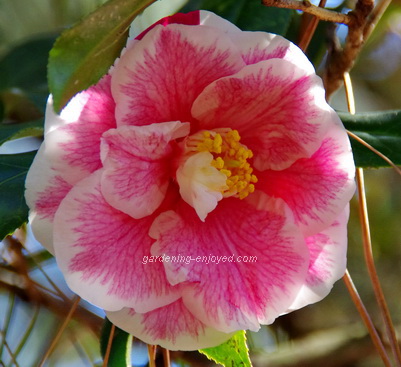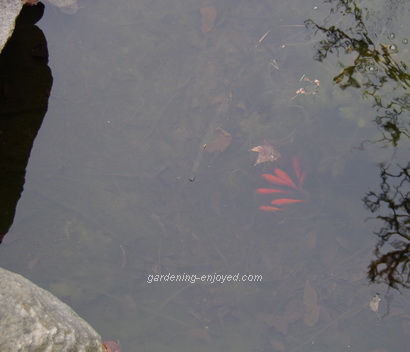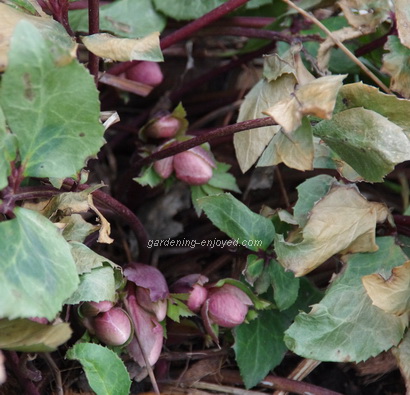| Back to Back Issues Page |
 |
|
Dallying In The Dirt, Issue #248--- Camellias are not really my cup of tea. February 09, 2016 |

Camellias aren’t really my cup of tea. I spent much of last week in Atlanta, inside a large room attending my Garden Writer’s board meeting. We did escape one day for a tour of Massee Gardens, the home of the Camellia Society of America. They had some 2000 cultivars of Camellias and they taught me that the plant that produces all of the world’s tea is actually a Camellia. They do have some lovely flowers that are produced on woody evergreen shrubs. Some were quite short and some were well over 3 meters tall. Maybe the fact that I will never see them in my garden is part of the reason for their limited appeal. Also I rarely, if ever, drink tea. They had a diversity of flower sizes and shapes all in the red, pink, white range. Some like “Yours Truly” pictured have variegated flowers and we learned that many of those varieties get their variegation from the infection of a virus. The breeders intentionally introduce the virus to develop new and interesting petal
variegations in their varieties. They also do have some that are genetic variegations and these tend to be more stable and therefore more desirable. The gardens are certainly worth a visit if you are traveling in that area. It’s just a few minutes off the I75 if your are looking for an interesting break while traveling south. We also found a great store that belonged to a large Pecan orchard and indulged ourselves. In doing so we discovered that there are several varieties of Pecans commercially grown. The Atlanta Botanical Garden is also worth a visit. The Assistant Gardener stayed home and did a wonderful job of keeping all the Begonia seedlings alive and growing.  I came back home to the winter that refuses to happen. There is no snow cover protecting my perennials or giving my skis a place to slide. The ponds have no ice and the poor fish are huddled at the bottom trying to figure out what is happening. The bubblers are happily bubbling but they aren’t really that necessary. They are usually replacing the air that the water would pick up if it was tumbling over the waterfall but with the surface completely free of ice that air water exchange is happening fairly well. All I can do is retreat to the basement and plant some more seeds and start some more bulbs. On the kitchen counter some of the Amaryllis are blooming. I did not buy any new ones this year so these are ones that I have successfully kept over the summer and they are now re-blooming. It’s not difficult.
I came back home to the winter that refuses to happen. There is no snow cover protecting my perennials or giving my skis a place to slide. The ponds have no ice and the poor fish are huddled at the bottom trying to figure out what is happening. The bubblers are happily bubbling but they aren’t really that necessary. They are usually replacing the air that the water would pick up if it was tumbling over the waterfall but with the surface completely free of ice that air water exchange is happening fairly well. All I can do is retreat to the basement and plant some more seeds and start some more bulbs. On the kitchen counter some of the Amaryllis are blooming. I did not buy any new ones this year so these are ones that I have successfully kept over the summer and they are now re-blooming. It’s not difficult. The Atlanta Botanical Garden had dozens of Hellebores in full bloom and many of them were already fading. That sent me out to check on my one Hellebore. It was full of fat, coloured buds and if this warm weather keeps up it should be in full bloom soon. It also has a significant collection of dry brown leaves. Each year I vow to move it. It is on the south facing slope, in front of a large stone. This subjects it to some strong sunlight and warmth that seems to fry the leaves. I need to find a shadier spot for it or at least a spot that doesn’t magnify the heat of the sun. I’m surprised how well it is going to flower despite the abuse I heap upon it. Hellebores are very popular now and there is quite a wide range of flower colours available. Their big attraction being the great floral display so early in the spring. Just do as I say and not as I do. Protect them from direct sun and they will perform well for you.
The Atlanta Botanical Garden had dozens of Hellebores in full bloom and many of them were already fading. That sent me out to check on my one Hellebore. It was full of fat, coloured buds and if this warm weather keeps up it should be in full bloom soon. It also has a significant collection of dry brown leaves. Each year I vow to move it. It is on the south facing slope, in front of a large stone. This subjects it to some strong sunlight and warmth that seems to fry the leaves. I need to find a shadier spot for it or at least a spot that doesn’t magnify the heat of the sun. I’m surprised how well it is going to flower despite the abuse I heap upon it. Hellebores are very popular now and there is quite a wide range of flower colours available. Their big attraction being the great floral display so early in the spring. Just do as I say and not as I do. Protect them from direct sun and they will perform well for you.Now it’s time to answer a few of my
reader’s questions. Don’t forget to check the front page of the Website for frequent short ideas for current gardening activities. Rasheed Asks? With spring like weather in Jan and February, should we plan for an early frost last date in late March? |
| Back to Back Issues Page |